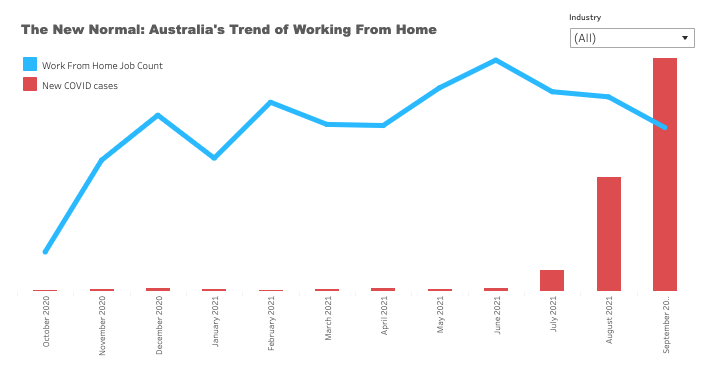
With intermittent lockdowns, the rise in Delta cases, and the pandemic well on its way to reaching its 2-year anniversary, we’re still discovering the ways that COVID-19 has affected the Aussie economy.
One change is the increased demand for work-from-home (WFH) jobs, both by employers and by applicants. More and more people want to work from home, and more companies are trying to manage the pandemic by allowing employees to work from anywhere with an internet connection.
But is this a “new normal” that we can expect to continue, or is it a response to the current state of the market? And are there any interesting data trends that we can identify that perhaps we can use to gain a better understanding of the mindset of employers? That’s what Rover is here to do, so let’s start by taking a look at the data.
Q1: Are Companies Simply Responding to New COVID Cases?
One of the first questions that we asked ourselves was if WFH jobs were truly a “new normal” or if they were more of a response to COVID cases.
What we found when running the data was that it is likely a mix of both.
Take a look at the charts below:
Based on the chart above, it absolutely appears that work from home jobs are at least partially related to COVID cases. As COVID cases trend up, so too does the number of WFH jobs that are put on the market. But it appears that this isn’t related to the cases themselves, but more so with Australia’s lockdowns.
This appears to be indicating that employers are still finding success and looking to grow, even when the country as a whole is essentially stuck in place, but perhaps they are merely responding to the government response, rather than using their own foresight.
You can explore these numbers further by adjusting the industries using the selection boxes on the top right, and if you’re interested in seeing where these job postings are (adjusted for state population) you can scroll over the chart to see additional data.
Q2: Where Are WFH Jobs More Common?
There’s an argument to be made that “work from home” employment is a luxury, or one that may be limited to specific careers, companies – even social and economic classes.
So it is interesting to see where these work from home jobs are being posted. It can give you an idea of which regions are either:
- Responding to the pandemic more strongly, or…
- More likely to have industries that can be maneuvered to remote work.
That is why, using Rover, we created the following map:
Scroll over any city or state and it is possible to identify the cities and states that have the most WFH job postings. Using Rover, each of these is adjusted for population based on 2020 census data. You can change the industries using the dropdown menu on the bottom right. You can also scroll over these to see which employers have been posting the most work from home jobs during our timeframe.
One thing that stood out to us almost immediately was Melbourne posting almost 25% more WFH jobs than Sydney. Since Melbourne is considered the Tech Capital of Australia, it’s definitely a sign that some positions are moving remote far more easily than others.
More and More Data to Parse
Massive books can – and probably will – be written on how the pandemic has affected the economy and likely sped up the transition to work from home. Since the pandemic is still not over, it’s also possible that even more changes are on the way.
We’ll continue to use Rover to see what we can discover, and if you’re interested in reviewing some of the more granular and valuable data that you can receive using the Rover app, contact our sales team, today.